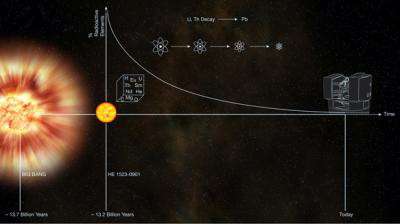A galactic fossil: Star is found to be 13.2 billion years old

How old are the oldest stars" Using ESO's VLT, astronomers recently measured the age of a star located in our Galaxy. The star, a real fossil, is found to be 13.2 billion years old, not very far from the 13.7 billion years age of the Universe. The star, HE 1523-0901, was clearly born at the dawn of time.
"Surprisingly, it is very hard to pin down the age of a star", the lead author of the paper reporting the results, Anna Frebel, explains. "This requires measuring very precisely the abundance of the radioactive elements thorium or uranium, a feat only the largest telescopes such as ESO's VLT can achieve."
This technique is analogous to the carbon-14 dating method that has been so successful in archaeology over time spans of up to a few tens of thousands of years. In astronomy, however, this technique must obviously be applied to vastly longer timescales.
For the method to work well, the right choice of radioactive isotope is critical. Unlike other, stable elements that formed at the same time, the abundance of a radioactive (unstable) isotope decreases all the time. The faster the decay, the less there will be left of the radioactive isotope after a certain time, so the greater will be the abundance difference when compared to a stable isotope, and the more accurate is the resulting age.
Yet, for the clock to remain useful, the radioactive element must not decay too fast - there must still be enough left of it to allow an accurate measurement, even after several billion years.
"Actual age measurements are restricted to the very rare objects that display huge amounts of the radioactive elements thorium or uranium," says Norbert Christlieb, co-author of the report.
Large amounts of these elements have been found in the star HE 1523-0901, an old, relatively bright star that was discovered within the Hamburg/ESO survey [1]. The star was then observed with UVES on the Very Large Telescope (VLT) for a total of 7.5 hours.
A high quality spectrum was obtained that could never have been achieved without the combination of the large collecting power Kueyen, one of the individual 8.2-m Unit Telescopes of the VLT, and the extremely good sensitivity of UVES in the ultraviolet spectral region, where the lines from the elements are observed.
For the first time, the age dating involved both radioactive elements in combination with the three other neutron-capture elements europium, osmium, and iridium.
"Until now, it has not been possible to measure more than a single cosmic clock for a star. Now, however, we have managed to make six measurements in this one star"," says Frebel.
Ever since the star was born, these "clocks" have ticked away over the eons, unaffected by the turbulent history of the Milky Way. They now read 13.2 billion years.
The Universe being 13.7 billion years old, this star clearly formed very early in the life of our own Galaxy, which must also formed very soon after the Big Bang.
Source: European Southern Observatory (ESO)





















